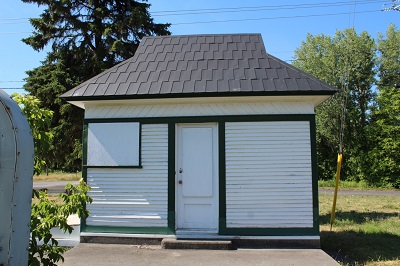Cabin at Bridge 2
Recognized Federal Heritage Building
Chambly, Quebec

Cabin of Bridge No. 2, main elevation
© Agence Parcs Canada / Parks Canada Agency, 2019.
Address :
Chambly, Quebec
Recognition Statute:
Treasury Board Policy on Management of Real Property
Designation Date:
1997-02-06
Dates:
-
1906 to 1907
(Construction)
Other Name(s):
-
Bridge 2
(Other Name)
-
Bridge N 2 Cabin
(Other Name)
-
(Other Name)
Custodian:
Parks Canada
FHBRO Report Reference:
96-067
DFRP Number:
06688 00
Description of Historic Place
The Cabin at Bridge 2 is located on a quiet stretch of the Chambly Canal National Historic Site of Canada. It is a small, wooden building with a shingled, broken gable roof. The walls are clad in white, horizontal wood siding with green trim. A doorway, also trimmed in green, is centrally located on the front of the building. The designation is confined to the footprint of the building.
Heritage Value
The Cabin at Bridge 2 is a Recognized Federal Heritage Building because of its historical associations, and its architectural and environmental value.
Historical Value
The Cabin at Bridge 2 is associated, along with the other cabins and works on Chambly Canal, with the days when the canal was a major commercial route for the Québec logging industry. The cabin, built as a workstation and storage, also recalls the years when the canal was a source of employment for the local community.
Architectural Value
The Cabin at Bridge 2 is valued for its good aesthetic and functional design. The small wooden cabin illustrates the desire among authorities in the early 20th century to beautify the Chambly Canal by replacing all the small canal buildings with ones of a compatible, picturesque design. The influence of the Queen Anne Revival style chosen for these buildings is less pronounced here than in the other associated cabins. However, the good condition of this little building is a sign that fine materials and sound building techniques were used.
Environmental Value
The Cabin at Bridge 2 is compatible with the present character of is canal setting and is a familiar building in the immediate area.
Sources: André Sévigny et Paul Trépanier, Logettes des écluses 7 et 8 et des ponts 2 et 5, canal de Chambly, Québec, Federal Heritage Buildings Review Office, Building Report, 96-067; Cabin at Bridge 2, Chambly Canal, Québec, Heritage Character Statement, 96-067.
Character-Defining Elements
The character-defining elements of the Cabin at Bridge 2 should be respected.
Its good aesthetic and functional design and very good craftsmanship and materials, for example: the architectural lines that link this small wooden cabin with the other cabins on the canal such as the complex broken-gable roof profile, the contrasting textures and colours adorning the wood siding, and the resulting compartmented effect; the building materials and techniques that have stood a century, reflecting the skill and expertise of the artisans involved in this work.
The manner in which the Cabin of Bridge 2 is compatible with the present character of its canal setting and is a familiar building in the immediate area, as evidenced by: its overall scale, massing design and materials that maintain a visual and physical relationship with the adjacent canal works and the swing bridge nearby; its good visibility, which, together with its sister cabins, gives structure to the landscape along the Chambly Canal National Historic Site of Canada.
Heritage Character Statement
Disclaimer -
The heritage character statement was developed by FHBRO to explain the reasons for the designation of a federal heritage building and what it is about the building that makes it significant (the heritage character). It is a key reference document for anyone involved in planning interventions to federal heritage buildings and is used by FHBRO in their review of interventions.
Reasons for Designation
The cabin of Bridge No. 2 has been designates as a “Recognized” building primarily because of its architectural qualities and environmental significance.
Historical Value
The Cabin of Bridge No. 2, along with the other cabins and works on Chambly Canal, evokes the days when the canal was a major commercial route for the Québec logging industry. The cabin also recalls the years when the canal was a source of employment for the local community. The cabin of Bridge No. 2 is part of the Canal-de-Chambly National Historic Site of Canada.
Architectural Value
This small wooden cabin illustrates the desire among authorities in the early 20th century to beautify the Chambly Canal by replacing all the small canal buildings. The influence of the Queen Anne style is less pronounced here than in the other cabins. However, the good condition of this little building is a sign that fine materials and sound building techniques were used.
Environmental Value
This cabin has never been moved from its original site, and its relationship with the canal works, including bridges, locks, the drafting road and the canal itself, has changed very little. Located on a quieter stretch of the canal, it is nevertheless a structuring component of the linear landscape of the Chambly Canal.
Character-Defining Elements
- The architectural lines that link this small wooden cabin with the other cabins on the canal (in which the Queen Anne style is more pronounced), such as the complex broken-gable roof profile; the contrasting textures and colours adorning the wood siding; and the resulting compartmented effect.
- Building materials and techniques that have stood a century reflecting the skill and expertise of the artisans involved in this work.
- The relationship between the cabin of Bridge No. 2 and the site as well as the other canal works, in particular the swing bridge located nearby.
- The “clean” landscaping, which reflects the spirit of beautification of the landscape that led to the construction of this cabin.
- The good visibility of the cabin, which, together with its sister cabins, gives structure to the landscape along the Chambly Canal.